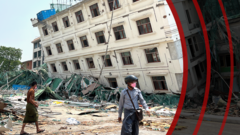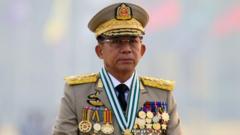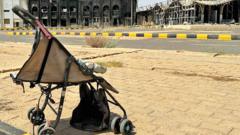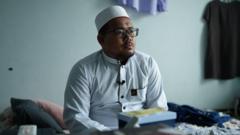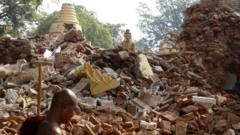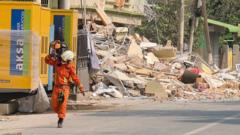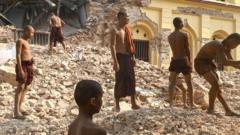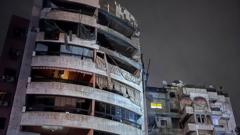Following a catastrophic earthquake, Myanmar's military government faces accusations of weaponizing humanitarian aid by blocking access to affected regions, complicating relief efforts. Despite a plea for international support by the junta's leader, access remains restricted in areas controlled by resistance groups, raising concerns about the true intentions behind the military's actions.
Humanitarian Aid in Myanmar: A Double-Edged Sword Amidst Political Turmoil
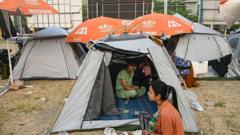
Humanitarian Aid in Myanmar: A Double-Edged Sword Amidst Political Turmoil
In the wake of a devastating earthquake, military hindrances and conflicting agendas shape the delivery of crucial aid in Myanmar.
On March 28, Myanmar experienced a catastrophic earthquake registering a magnitude of 7.7, resulting in over 2,886 fatalities. In the critical first 72 hours after such disasters, the chance of saving lives diminishes significantly, yet humanitarian workers faced obstructions imposed by military authorities. The military’s blockade of aid access came on the heels of junta leader Min Aung Hlaing's call for international humanitarian assistance, claiming to "open all ways for foreign aid"—a statement that contrasts sharply with ground realities reported by aid organizations.
John Quinley from Fortify Rights illustrated the obstacles faced by rescuers: extended curfews, overwhelming checkpoints, and complicated goods inspections, which he deems unnecessary under the circumstances. It was noted that humanitarian aid is often selectively directed by the junta, used as a tactical tool rather than an act of goodwill. The military's manipulation of aid dynamics, particularly in areas under resistance control, is not a new occurrence.
Reports made by the Ta'ang National Liberation Army indicate that an aid convoy was fired upon by the military as it attempted to deliver relief supplies, further highlighting the hostility towards independent aid efforts. Quinley asserts that the military routinely impedes humanitarian operations, seeking to restrict support to regions aligned with their governance, and often targeting or obstructing aid workers directly.
The 2023 earthquake raises alarm as many regions subsequently categorized as hard-hit are considered strongholds of resistance forces opposing the junta. Aid groups must navigate complex bureaucratic hurdles to deliver assistance, as seen with requirements for advance approval from military authorities—an approach designed to exert control over humanitarian responses.
While local community volunteers have stepped in to provide rescues, the lack of support from the military has resulted in severe shortages of food, water, and shelter, with many victims left homeless and in dire conditions. Attempts to assist have frequently been stalled at military checkpoints, and bureaucratic red tape often hinders relief distribution.
Despite Min Aung Hlaing’s recent announcement of a temporary ceasefire intended to assist in relief efforts, this gesture has drawn skepticism. The military had previously engaged in strikes that resulted in civilian casualties, raising questions about their commitment to providing unimpeded access for aid.
Humanitarian organizations remain hopeful that increased scrutiny will pressure the junta to facilitate relief effectively, but concerns about aid targeting and accessibility persist. The historical context of the junta’s past deceptions prompts caution regarding the actual allocation of aid resources.
With many organizations operating discreetly to distribute aid beyond the military's purview, the situation remains critical. Experts emphasize the need for continued vigilance and verification to ensure aid reaches those most in need amidst the ongoing conflict between military forces and resistance groups. The tragedy illustrates the complexities of humanitarian work in a politically fractured environment where aid can swiftly become a tool of oppression rather than support.

